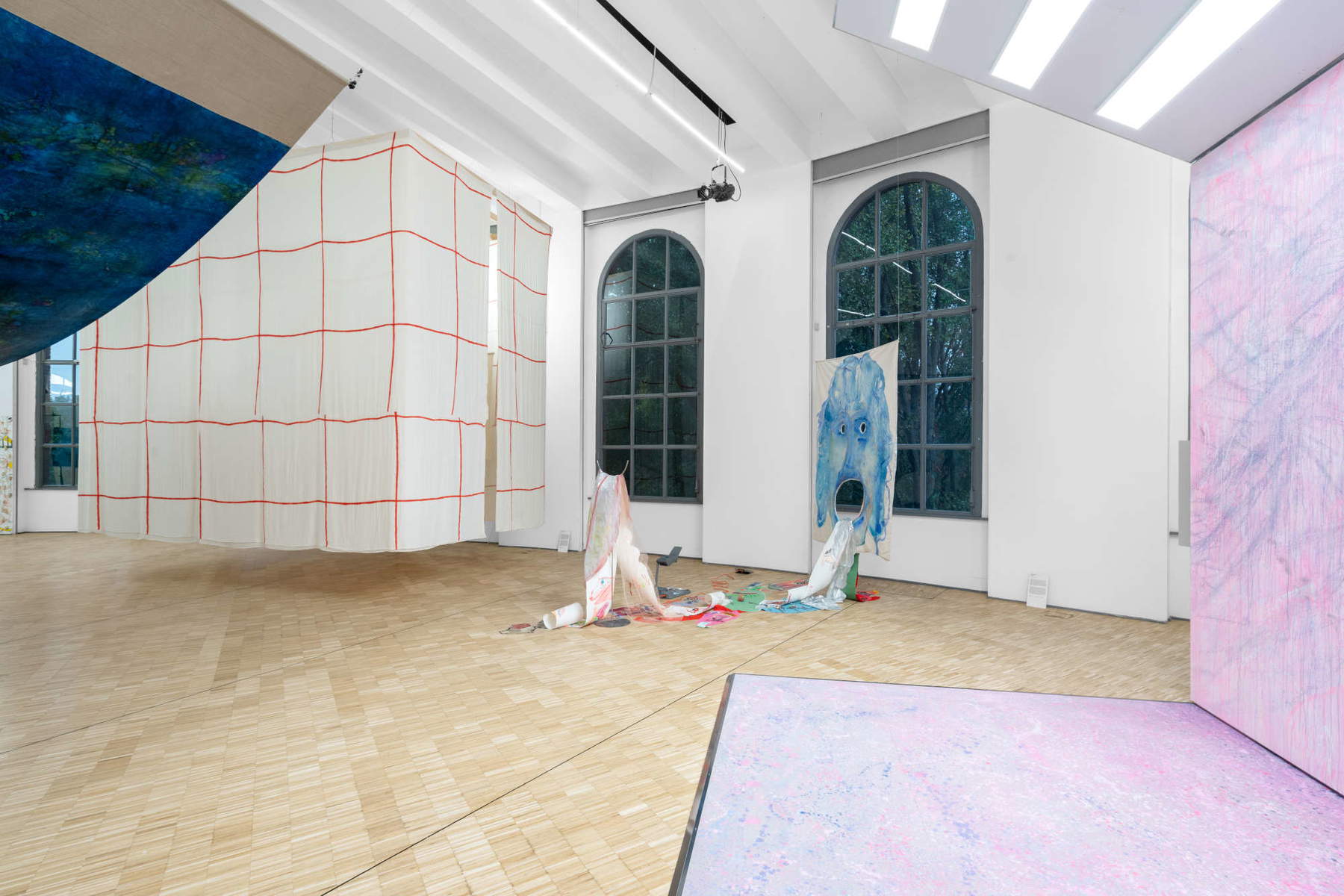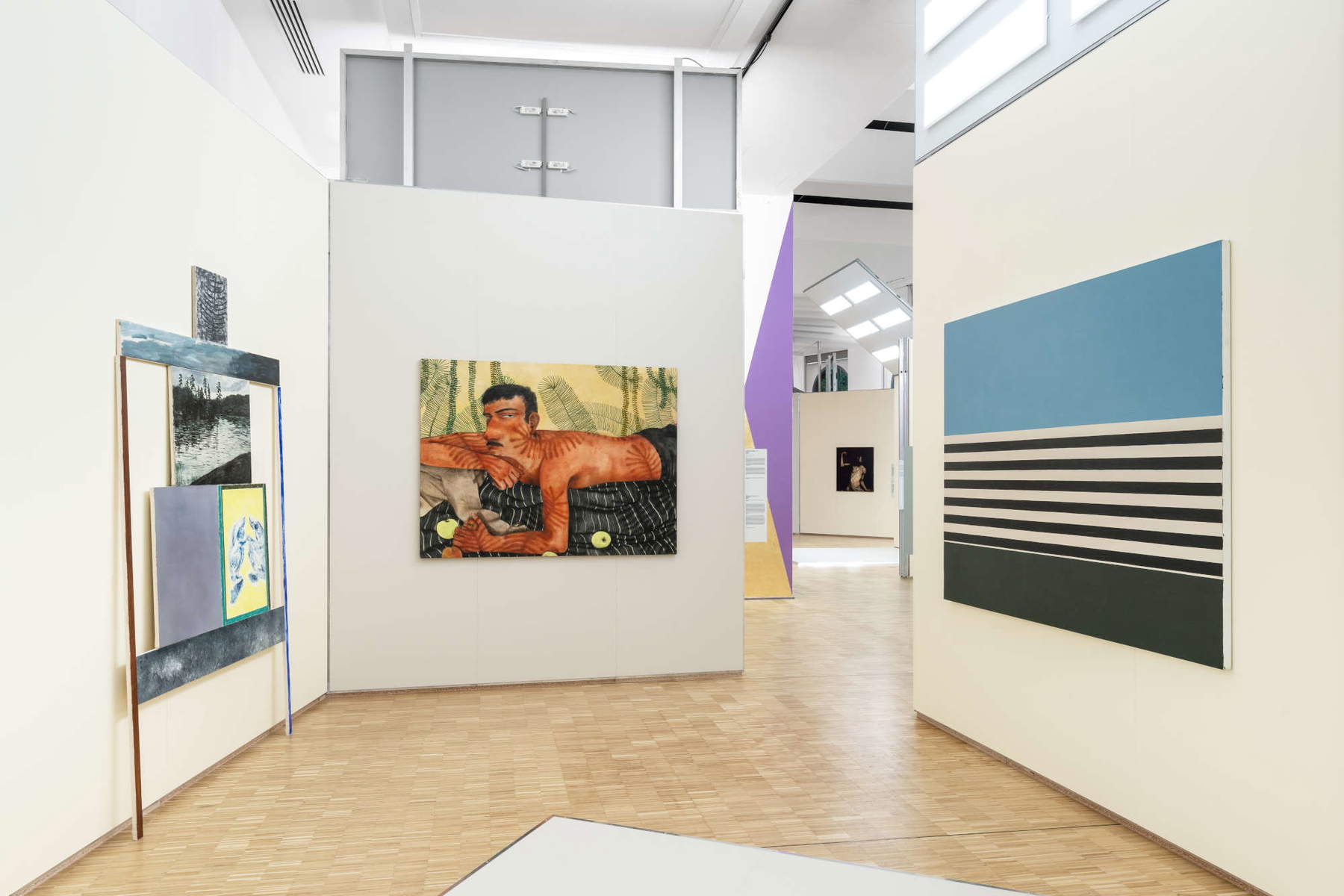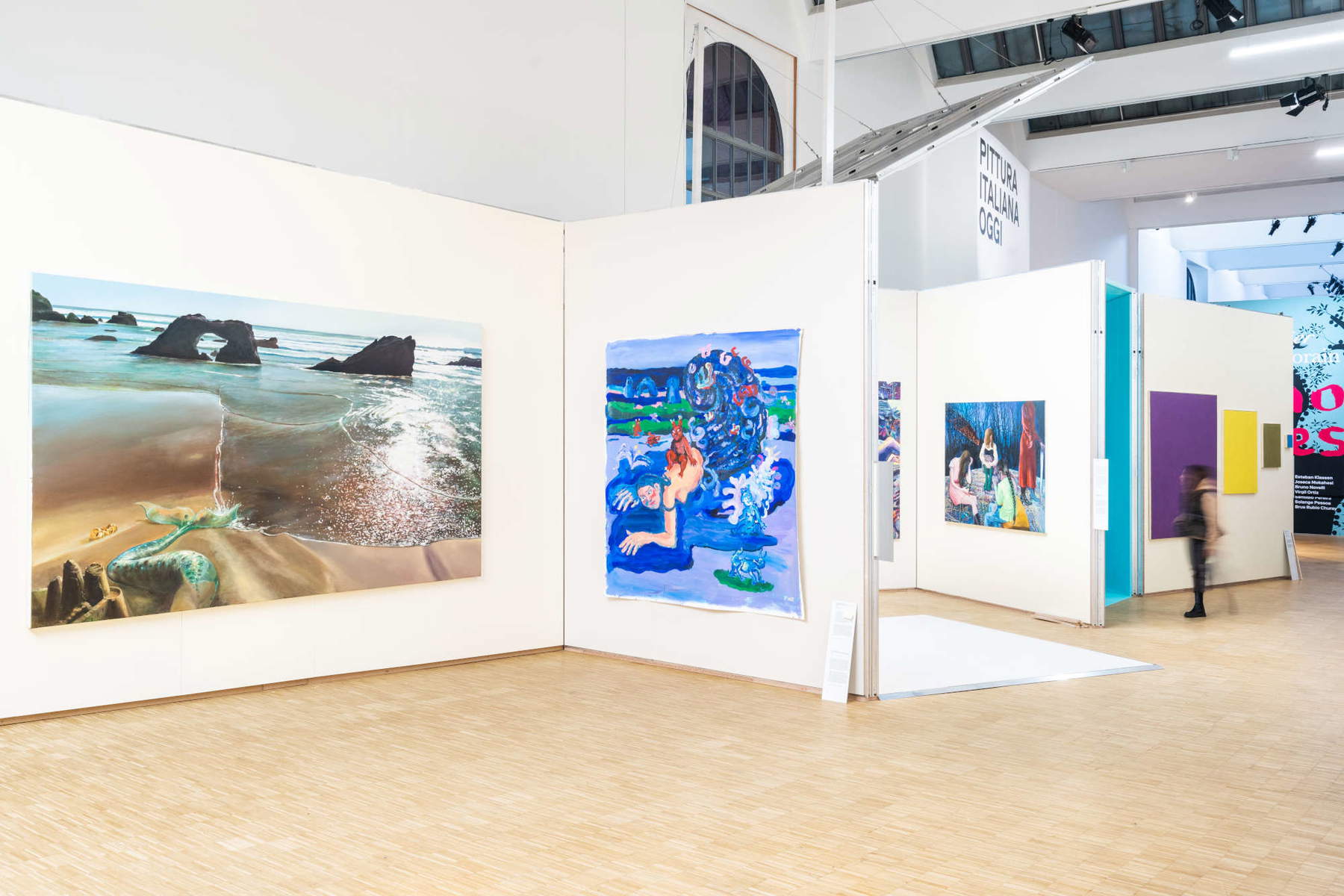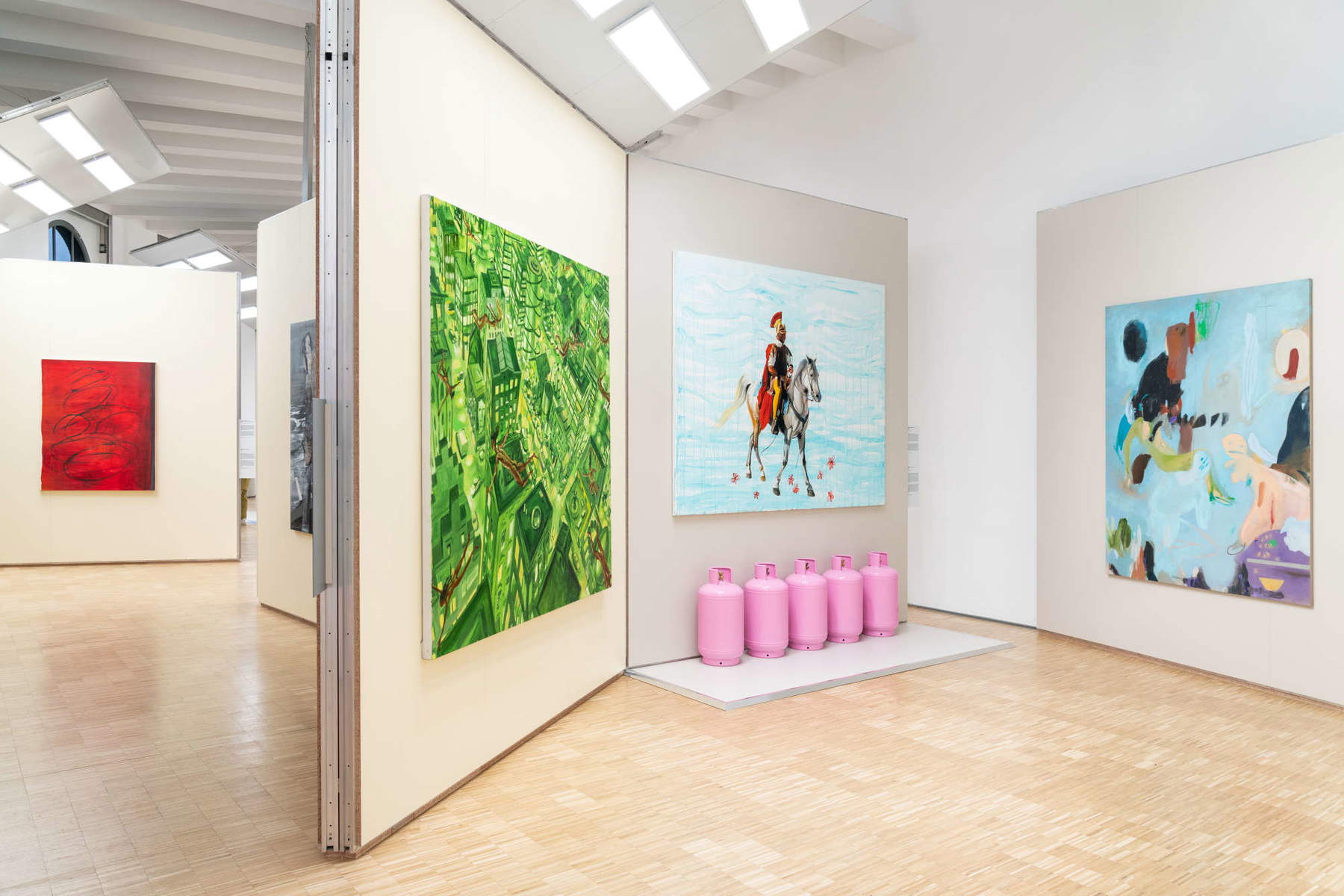I think the best assessment of the exhibition Pittura italiana oggi, the large group show that brings together the work of 120 painters at the Milan Triennale, is the sense of surprise that Davide Ferri notes in his essay published in the exhibition catalog itself: “I find it hard to believe that anyone has had the courage to make an exhibition that has the ambition to open up so broadly on Italian painting of our time. An exhibition, that is, that includes the painters who have established themselves over the last few decades, a period that is, to say the least, complicated, rambling, fragmentary, at times even stuttering, and who are now in their twenties to thirties to about sixty years old, bringing them all back to the present, with one work each, made, roughly, in the last three years.” From such an exhibition, Ferri adds, “I don’t know how you can get out of it alive.” And indeed, curator Damiano Gullì immediately ended up, perhaps even before the exhibition opened, in the meat grinder of social media, where so many engaged in a kind of pigeon shooting against the unfortunate man, mainly because of the forgetfulness, or alleged forgetfulness, that would characterize the layout of the exhibition (disagreeing artists will still be able to organize their own salon des refusés: we would immediately find ourselves catapulted back to 1863, but then again, even Pittura italiana today does not respond to highly topical models).
The problem with the exhibition, however, is not so much the list of participants, or the list of non-participants. One could spend hours drawing up lists of artists-who-should-have-been-there-but-aren’t-there, an operation that would in any case be devoid of merit, since Pittura italiana oggi is not based on criteria beyond the very personal choices of the curator. He himself admits this at the beginning of his essay in the catalog: "Pittura italiana oggi was born from study visits, research and encounters, human and professional, with artists who, throughout Italy, paint.“ A series of encounters (we will focus on this term because the other one, ”researches,“ is not further specified, and we will therefore take it as a noun put in a sequence with the sole purpose of better balancing the text from a formal point of view) that, Gullì explains, would have brought out a scene ”of extraordinary liveliness“ (who would have thought it!). The only skimming is anagraphic: ”the breadth of the panorama surveyed led to the identification of practices and poetics of one hundred and twenty women artists, born between 1960 and 2000, and to focus on the selection of works made between 2020 and 2023." It is not given to know why one hundred and twenty, it is not given to know why only works from the period 2020-2023, it is not given to know why the selection concerns only artists between twenty-three and sixty-three years of age. Byzantine criterion, the latter, which led to the exclusion, and here some names can be made since these are artists out of the age range , of, for example, a Rudolf Stingel, a Giovanni Frangi, a Wainer Vaccari, just to name three painters certainly no less fundamental than most of those who make up the “extraordinarily lively” scene of Italian Painting today and who have been working hard in the last four years. But what sense does a selection by age make in an art exhibition that purports to provide “mapping,” as the curator puts it? Not even competitions for city officials have age limits. Maybe then clarifications will come and the curator will explain how, in his opinion, it is possible to perform a “mapping” of contemporary Italian painting by establishing age boundaries, why he chose certain artists and others not, what rules guided him in his choice, but as a rule when organizing an exhibition the project should be explained first.



Now, it has been said above that the selection is the result of the curator’s personal choices. An eventuality that would be completely normal if, let’s say, the exhibition focused around a theme: I talk about the fragility of the human body rendered in painting and I convene a number n of artists who, for quality, coherence, effectiveness, originality, and visionary ability I think are the most suitable to develop the topic. Or if, more generically, I identify some trends in the current scenario of Italian painting and gather the artists I consider most representative (in this sense, however, Gullì immediately puts a screen between himself and the audience: “it is not easy to identify specific groups or trends. Each individuality contributes to delineating a polyphonic choral narrative, in which common, if idiosyncratic, attitudes and visions are detectable under the surface.”) One could then establish less subjective criteria should one wish to give a historical slant to the exhibition (after all, Pittura italiana oggi contains works by some artists who began painting just after the Transavanguardia). Wanting to believe that terms set in black on white in an essay still have value and meaning, how can one think that a “mapping” can be derived from an exhibition that is anagrammatically limited and has been constructed on the basis of the curator’s personal encounters? Besides, how many painters are there in Italy today? One thousand? Two thousand? Five thousand? Ten thousand? So how extensive must this “mapping” be to aspire to have any minimal descriptive claim? And, above all, how frequent must it be? In a lively and dynamic scenario, even the mere thought of being able to really lay out a mapping runs the danger of being an overly ambitious idea, but the idea of being able to do so with a one-off initiative, reduced to only one hundred and twenty artists, moreover devoid of discoveries or revelations (even the young people in the exhibition are painters who have already exhibited in relevant contexts or have otherwise been launched by others, be they galleries or institutes, who have really done research), devoid of comparisons, devoid of frames, and therefore wholly insufficient, is also immodest and pretentious. More than a mapping, Pittura italiana today looks like a sketch, a pencil sketch.
On the other hand, one also has to wonder how current the model of the nineteenth-century salon-style mega-exhibition can be. Between the nineteenth and twentieth centuries, similar exhibitions were widespread and repeated: in Italy there was a galaxy made up of promoters’ exhibitions, academic exhibitions, biennials and triennials, and national fine arts exhibitions (which were often reviews of three-four-five-hundred-thousand works), with a panorama that was certainly not as varied, complex, and multifaceted as today’s. Today, any exhibition that has a compilative intent cannot but appear risky and out of time. Pittura italiana oggi is therefore nothing more than a delightful rearguard operation, even declared, since the ideal model to which the exhibition refers, from what we read in the presentations, are the exhibitions of mural painting that were organized in the Palazzo dell’Arte starting in 1933. An operation as well penalized by a very bad set-up, cramped, tortuous, trivial, from a fair of secondary importance.
Surprising then is the naivete of the conclusions reached by Gullì in his essay (in which, moreover, the curator eludes any in-depth study of a critical nature, preferring to concentrate on the pure description of the themes addressed by the selected artists): the exhibition, he writes after addressing the trite topic of chatter about the supposed death of painting, “ascertains a state of fact: painting is.” Did Gullì’s filing needed to realize that in 2023 there are people painting in Italy? Little to add, then, about such a badly aboriginal operation, which adds nothing new, offers no critical look at the present, does not even make a minimum of order, but limits itself to sowing, through the halls of the Triennale, the works of a certain number of artists taken here and there without one knowing according to what parameters. A weak exhibition put together by a compiler rather than a curator. Or a “marathon of painting,” as Francesco Bonami called it in his essay in the catalog (never, moreover, had it happened to me to leaf through the catalog of an exhibition and find essays in it expressing, albeit veiled, perplexities about the exhibition itself), in the impossibility of organizing a 100-meter final to determine who is the best, given the too large number of competitors.
There is not much to say about the course, unless one wants to adopt the methods of early 20th century critics, who usually summarily judged the works of individual artists and tried to determine who were the best and who were the worst. Or one may enjoy going into detail about the juxtapositions in subjects, techniques, colors and so on that shape the tour itinerary: the only way to talk about this exhibition without criticizing anyone (and thus the mode most practiced by those who find themselves writing about Italian Painting Today) and then agree with the curator on the idea of an “extraordinary liveliness” of the Italian scene. A sort of exercise in style, in essence. Impossible, given the substantial lack of a project founded on solid foundations, to find a way to approach the exhibition in other ways. One could at most discuss the concept of “liveliness”: what does it mean? If the idea is to show that there are many painters in Italy, and therefore it is a liveliness supported by the mere quantitative parameter, then yes, we all agree. If, on the other hand, what is meant is a “liveliness” of ideas, Pittura italiana oggi is a negligible exhibition, since it lacks any comparison with the international scene, any critical discourse on Italy’s position in a broader context, any critical discourse on the relations between the painters of today and those of yesterday, and so on.



What is the purpose then of visiting it? Three reasons come to mind. First, because it is the classic exhibition for lazy people, we might say. Those who don’t feel like wandering around fairs, galleries, artist’s studios, more or less large solo and group shows up and down Italy have the convenience of having a good collection all in one place. Of course, the disadvantage lies in the fact that each artist has been asked for only one work, so if a visitor is unfamiliar with a given painter, he or she will not be able to get an idea, but perhaps can jot down the name for later study. In short, one can visit Pittura italiana oggi in the same spirit with which one visits a fair, albeit with less expectation: in a fair an artist is usually present with several works, and if the visitor has the face of one who is intent on spending on that artist, he will have at his disposal a gallery attendant ready to tell him everything the painter has done from first grade to the present. Second, because there are several very good painters in the exhibition anyway (we have also covered some of them extensively in Finestre Sull’Arte, both online and in print, with lengthy in-depth articles). And it could not have been otherwise: if you organize an exhibition with one hundred and twenty artists by putting together a few emblazoned names, a few established artists, and for the young ones you avoid taking the risk of searching in the obscure meanderings of some little-known gallery or in the corridors of some academy and prefer to focus mainly on those who have already had relevant experience or have been discovered by others, by the law of large numbers being able to nab twenty or so good artists is purely a matter of arithmetic. Third, because it is fun. Those who follow contemporary art can enjoy, say, doing what sports journalists who follow soccer do. Like, "Painter X shows up for his appointment with Pittura italiana oggi in remarkably fine form !“ ”Painter Y has had a decline in the last few months and his performance at the exhibition has turned out to be really underwhelming !“ ”Painter Z has done an impeccable preparation and in Pittura italiana today he showed off a truly capital performance !"
Concluding his paper, Ferri poses a question, “in what does the force that a painted image is still able to exert in a time of uncontrolled proliferation of images consist?” Very interesting question. Only the visitor has no basis with which to confront it. The willing will try to give themselves an answer. The exhibition in this sense is very open (the audience will determine whether it is by intentionality or lack of ideas). But it is also fine to visit the exhibition exactly as one goes to watch a soccer game. With the audience commenting on the performances of those who took the field and complaining about those who were left on the bench. With the players making comments after the game about their personal performance during the match. With legions of fans siding with one or the other team.
Warning: the translation into English of the original Italian article was created using automatic tools. We undertake to review all articles, but we do not guarantee the total absence of inaccuracies in the translation due to the program. You can find the original by clicking on the ITA button. If you find any mistake,please contact us.